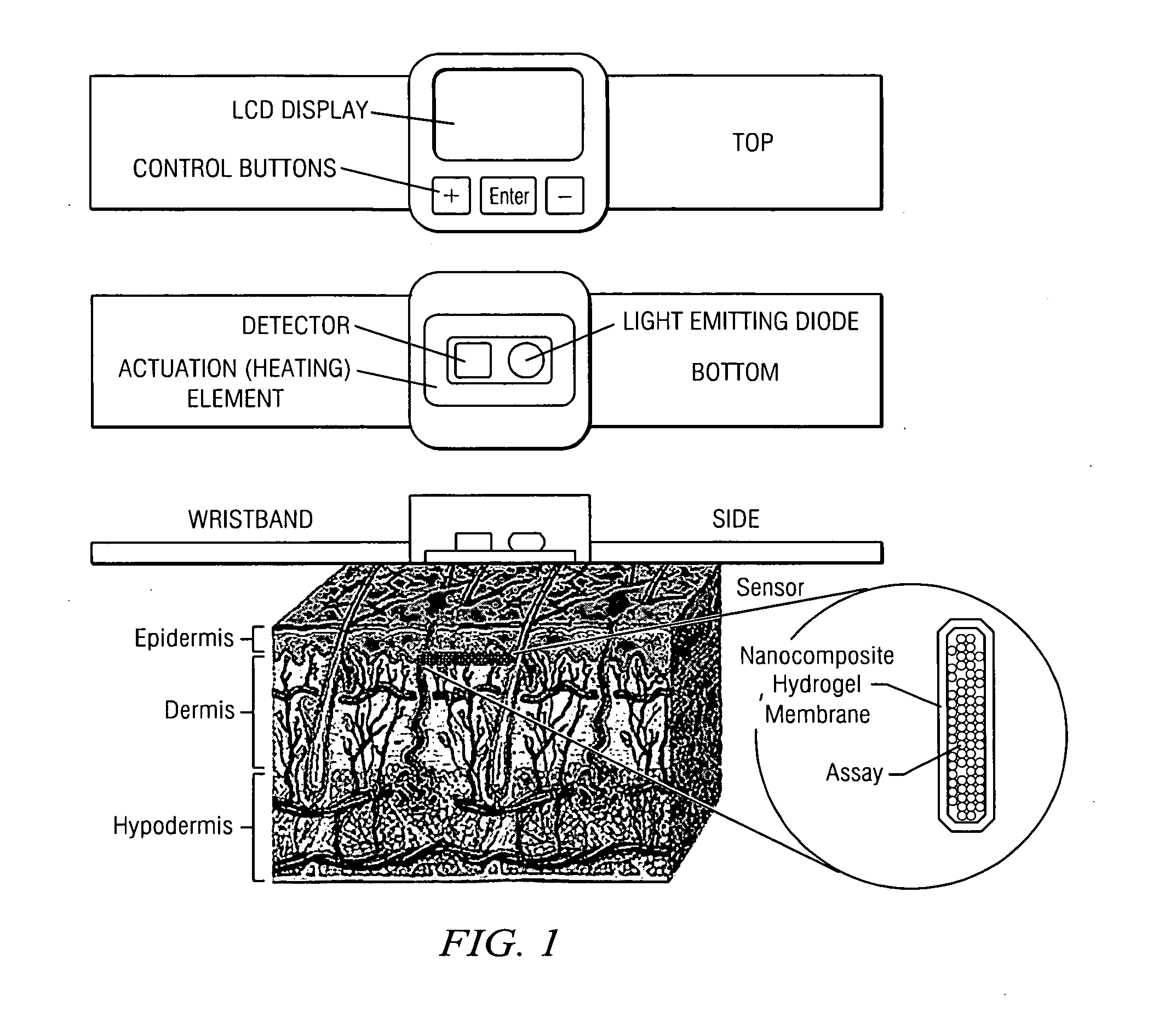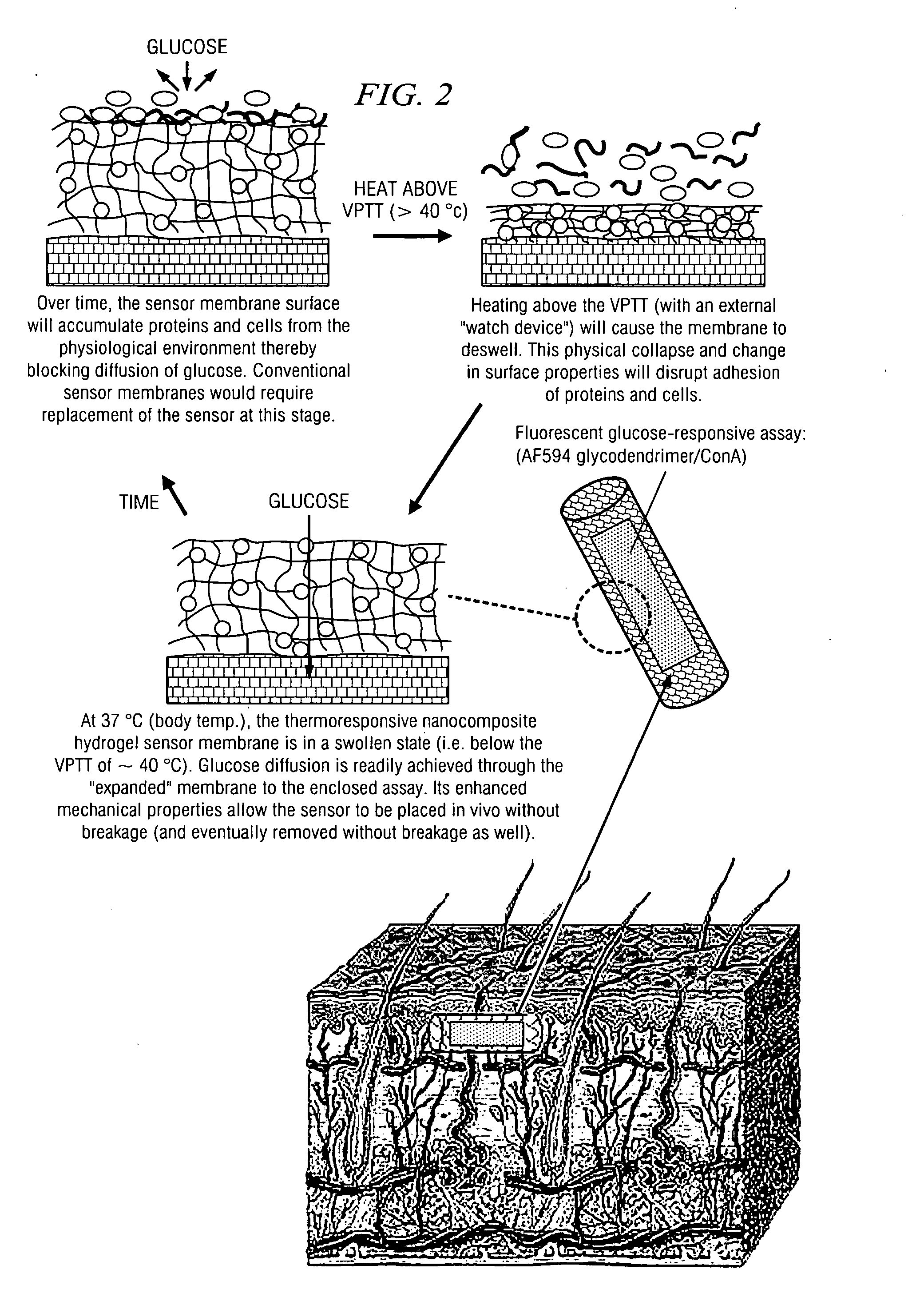Self-Cleaning Membrane for Implantable Biosensors
a biosensor and self-cleaning technology, applied in biomass after-treatment, enzymology, biological testing, etc., can solve the problems of inability to accurately detect analyte, and inability to achieve uniform diffusion, so as to minimize or eliminate the effect of reducing the lifetime of the implanted biosensor
- Summary
- Abstract
- Description
- Claims
- Application Information
AI Technical Summary
Benefits of technology
Problems solved by technology
Method used
Image
Examples
example 1
Materials
[0041]Liquid poly(ethylene glycol) diacrylate (MW 575), poly(ethylene glycol) (MW 1000), N-isopropylacrylamide (NIPAAm), potassium persulfate, sodium carbonate, and glucose (HK) assay were purchased from Sigma-Aldrich (St. Louis, Mo.). 2-Hydroxy-2-methyl-1-phenyl-1-propanone (Darocur 1173) and 1-[(2-hydroxyethoxy)-phenyl]-2-hydroxy-2-methyl-1-propane-1-one (Irgacure 2959) were obtained from Ciba Specialty Chemicals (Tarrytown, N.Y.). N,N′-methylene bis-acrylamide (BIS) was purchased from Acros Organics (Geel, Belgium). Octamethylcyclotetrasiloxane (D4) and 1,3,5,7-tetramethyl-1,3,5,7-tetravinylcyclotetrasiloxane (D4Vi) came from Gelest and dodecylbenzenesulfonic acid (DBSA, BIO-SOFT®) came from Stepan. The Slide-A-Lyzer dialysis cassette (MWCO 10,000) was obtained from Pierce (Rockford, Ill.). All aqueous experiments were performed with deionized water with a resistance of 18 MΩ·cm (Millipore, Billerica, Mass.).
example 2
Nanoparticle Synthesis
[0042]Crosslinked polysiloxane colloidal nanoparticles with an average diameter of 219 nm and particle sizes ranging from 106 to 531 nm were prepared according to Hou et al. First, cationic emulsion polymerization of octamethylcyclotetrasiloxane and 1,3,5,7-tetramethyl-1,3,5,7-tetravinylcyclotetrasiloxane with dodecylbenzenesulfonic acid as an initiator and surfactant produced uncrosslinked nanoparticles. After adjusting the pH to 7 with Na2CO3, the nanoparticles were crosslinked by free radical reaction of the vinyl groups of the copoly(dimethylsiloxane / methylvinylsiloxane) inside the particles. The nanoparticles were purified using a dialysis cassette with a molecular weight cut off (MWCO) of 10,000 with daily water changes for 3 days.
example 3
Sensor Membrane Fabrication
[0043]Three PNIPAAm-based hydrogels were prepared along with a poly(ethylene glycol) (PEG) hydrogel as a control. The composition of each precursor solution is shown in Table 1. (A) PNIPAAm aqueous solution was composed of 12.5 wt % NIPAAm monomer, 2 wt % BIS crosslinker, and 1 wt % Irgacure-2959 photoinitiator. (B) The modified PNIPAAm nanocomposite solution included 1 wt % polysiloxane colloidal nanoparticles (based on total precursor solution weight) in addition to the above materials. The solutions were purged with nitrogen for 10 minutes and injected into a glass mold. The mold was sealed and submerged into an ice water bath (˜7° C.). The solutions were photopolymerized by exposure to UV light for 10 minutes (9 mW / cm2, λpeak=365 nm, UVP UV-Transilluminator). The hydrogels were then rinsed with DI water and soaked for at least 24 hours to remove impurities and allow for adequate hydration. (C) Porated modified PNIPAAm nanocomposite hydrogels were creat...
PUM
| Property | Measurement | Unit |
|---|---|---|
| size | aaaaa | aaaaa |
| temperature | aaaaa | aaaaa |
| temperature | aaaaa | aaaaa |
Abstract
Description
Claims
Application Information
 Login to View More
Login to View More - R&D
- Intellectual Property
- Life Sciences
- Materials
- Tech Scout
- Unparalleled Data Quality
- Higher Quality Content
- 60% Fewer Hallucinations
Browse by: Latest US Patents, China's latest patents, Technical Efficacy Thesaurus, Application Domain, Technology Topic, Popular Technical Reports.
© 2025 PatSnap. All rights reserved.Legal|Privacy policy|Modern Slavery Act Transparency Statement|Sitemap|About US| Contact US: help@patsnap.com



